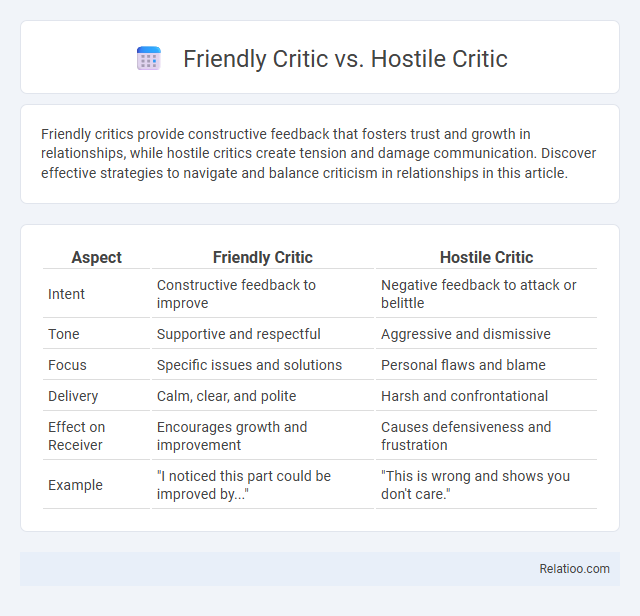Friendly critics provide constructive feedback that fosters trust and growth in relationships, while hostile critics create tension and damage communication. Discover effective strategies to navigate and balance criticism in relationships in this article.
Table of Comparison
| Aspect | Friendly Critic | Hostile Critic |
|---|---|---|
| Intent | Constructive feedback to improve | Negative feedback to attack or belittle |
| Tone | Supportive and respectful | Aggressive and dismissive |
| Focus | Specific issues and solutions | Personal flaws and blame |
| Delivery | Calm, clear, and polite | Harsh and confrontational |
| Effect on Receiver | Encourages growth and improvement | Causes defensiveness and frustration |
| Example | "I noticed this part could be improved by..." | "This is wrong and shows you don't care." |
Understanding the Role of Criticism
Friendly critics offer constructive feedback aimed at improvement, fostering positive growth and motivation. Hostile critics emphasize negative aspects, often hindering progress and creating resistance to change. Understanding the role of criticism involves recognizing how these differing approaches impact creativity, learning, and personal development.
Defining Friendly Critic: Constructive Feedback
A Friendly Critic provides constructive feedback aimed at helping You improve by highlighting strengths and offering actionable suggestions without judgment. Unlike a Hostile Critic, whose comments are often harsh and discouraging, a Friendly Critic fosters growth through supportive and clear communication. In contrast to a general Critic who may remain neutral, a Friendly Critic emphasizes positive reinforcement alongside areas for development.
Identifying Hostile Critic: Destructive Intent
A hostile critic exhibits destructive intent by aiming to undermine or diminish rather than provide constructive feedback, often using harsh or abrasive language that targets the individual instead of their work. Unlike a friendly critic who offers supportive and actionable suggestions, the hostile critic's comments lack helpful purpose and can create a negative emotional impact, impeding growth and learning. Identifying hostile critics involves recognizing patterns of personal attacks, dismissiveness, and a refusal to engage in productive dialogue.
Key Differences Between Friendly and Hostile Critics
A friendly critic offers constructive feedback aimed at helping you improve, focusing on positive reinforcement and specific suggestions. In contrast, a hostile critic delivers harsh, often personal attacks that can undermine your confidence without providing useful guidance. Understanding the key differences between these critics helps you discern valuable advice from destructive remarks, guiding your response and personal growth.
Signs You’re Dealing With a Friendly Critic
Signs you're dealing with a friendly critic include constructive feedback aimed at improvement rather than personal attacks or negativity. Friendly critics provide specific examples and actionable suggestions while maintaining a respectful and supportive tone. Unlike hostile critics who may be overly harsh or dismissive, friendly critics foster growth and collaboration.
Recognizing Hostile Criticism in Conversations
Recognizing hostile criticism in conversations involves identifying attacks that are personal, aggressive, or meant to demean rather than provide constructive feedback. Unlike friendly critics who offer supportive, solution-oriented input, or neutral critics who provide honest but impartial assessments, hostile critics use sarcasm, insults, or exaggerated negative language to undermine confidence. Being able to discern these differences helps maintain healthy communication and protects emotional well-being during discussions.
Emotional Impact: Friendly vs Hostile Critique
Friendly critics provide constructive feedback that fosters growth and encourages positive change, making Your emotional response more receptive and motivated. Hostile critics often deliver harsh or negative comments that can trigger defensiveness, stress, and diminished self-esteem, impacting Your emotional well-being adversely. Understanding the emotional impact of both friendly and hostile critique helps in managing responses and improving communication effectiveness.
How to Respond to Friendly Critics
Responding to friendly critics involves acknowledging their constructive feedback with gratitude and openness to foster positive communication and improvement. It is essential to engage thoughtfully with their suggestions, demonstrating receptiveness and encouraging ongoing dialogue that strengthens relationships. Addressing their points calmly and specifically can transform criticism into collaborative growth opportunities.
Handling Hostile Critics Effectively
Handling hostile critics effectively requires maintaining composure and reframing negative feedback as opportunities for growth rather than personal attacks. Unlike friendly critics who provide constructive and supportive input, hostile critics often communicate with aggression or negativity that can derail productive dialogue. Strategies such as active listening, setting boundaries, and responding with calm, fact-based statements help transform hostile criticism into a manageable conversation and foster a more constructive environment.
Cultivating a Culture of Constructive Criticism
A Friendly Critic provides supportive feedback aimed at improvement, while a Hostile Critic delivers harsh, often destructive comments that can hinder growth. Criticism, when balanced correctly, encourages reflection and development without damaging morale. Your ability to distinguish and foster Friendly Critic behaviors cultivates a culture of constructive criticism essential for continuous learning and enhancement.

Infographic: Friendly Critic vs Hostile Critic
 relatioo.com
relatioo.com